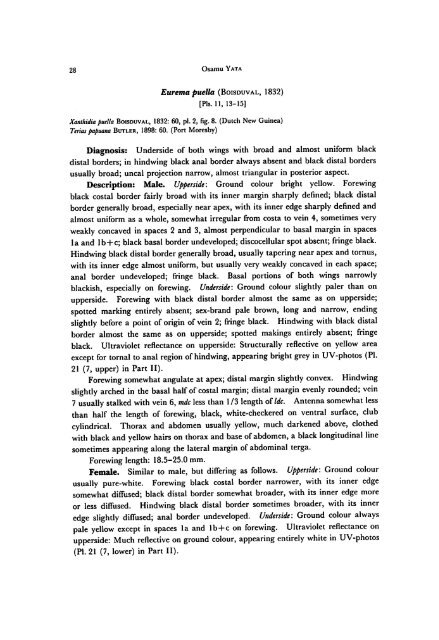A Revision of the Old World Species (Lepidoptera, Pieridae)
A Revision of the Old World Species (Lepidoptera, Pieridae)
A Revision of the Old World Species (Lepidoptera, Pieridae)
Create successful ePaper yourself
Turn your PDF publications into a flip-book with our unique Google optimized e-Paper software.
28 Osamu Yata<br />
Eurema puella (Boisduval, 1832)<br />
[Pis. 11, 13-15]<br />
Xanthidia puella Boisduval, 1832: 60, pi. 2, fig. 8. (Dutch New Guinea)<br />
Terias papuana Butler, 1898: 60. (Port Moresby)<br />
Diagnosis: Underside <strong>of</strong> both wings with broad and almost uniform black<br />
distal borders; in hindwing black anal border always absent and black distal borders<br />
usually broad; uncal projection narrow, almost triangular in posterior aspect.<br />
Description: Male. Upperside: Ground colour bright yellow. Forewing<br />
black costal border fairly broad with its inner margin sharply defined; black distal<br />
border generally broad, especially near apex, with its inner edge sharply defined and<br />
almost uniform as a whole, somewhat irregular from costa to vein 4, sometimes very<br />
weakly concaved in spaces 2 and 3, almost perpendicular to basal margin in spaces<br />
la and lb+c; black basal border undeveloped; discocellular spot absent;fringe black.<br />
Hindwing black distal border generally broad, usually tapering near apex and tornus,<br />
with its inner edge almost uniform, but usually very weakly concaved in each space;<br />
anal border undeveloped; fringe black. Basal portions <strong>of</strong> both wings narrowly<br />
blackish, especially on forewing. Underside: Ground colour slightly paler than on<br />
upperside. Forewing with black distal border almost <strong>the</strong> same as on upperside;<br />
spotted marking entirely absent; sex-brand pale brown, long and narrow, ending<br />
slightly before a point <strong>of</strong>origin <strong>of</strong>vein 2; fringe black. Hindwing with black distal<br />
border almost <strong>the</strong> same as on upperside; spotted makings entirely absent; fringe<br />
black. Ultraviolet reflectance on upperside: Structurally reflective on yellow area<br />
except for tornal toanal region <strong>of</strong>hindwing, appearing bright grey in UV-photos (PI.<br />
21 (7, upper) in Part II).<br />
Forewing somewhat angulate at apex; distal margin slightly convex. Hindwing<br />
slightly arched in <strong>the</strong> basal half <strong>of</strong>costal margin; distal margin evenly rounded; vein<br />
7usually stalked with vein 6, mdc less than 1/3 length <strong>of</strong>lie. Antenna somewhat less<br />
than half <strong>the</strong> length <strong>of</strong> forewing, black, white-checkered on ventral surface, club<br />
cylindrical. Thorax and abdomen usually yellow, much darkened above, clo<strong>the</strong>d<br />
with black and yellow hairs on thorax and base <strong>of</strong>abdomen, a black longitudinal line<br />
sometimes appearing along <strong>the</strong> lateral margin <strong>of</strong>abdominal terga.<br />
Forewing length: 18.5-25.0 mm.<br />
Female. Similar to male, but differing as follows. Upperside: Ground colour<br />
usually pure-white. Forewing black costal border narrower, with its inner edge<br />
somewhat diffused; black distal border somewhat broader, with its inner edge more<br />
or less diffused. Hindwing black distal border sometimes broader, with its inner<br />
edge slightly diffused; anal border undeveloped. Underside: Ground colour always<br />
pale yellow except in spaces la and lb+c on forewing. Ultraviolet reflectance on<br />
upperside: Much reflective on ground colour, appearing entirely white in UV-photos<br />
(PI. 21 (7, lower) in Part II).
















